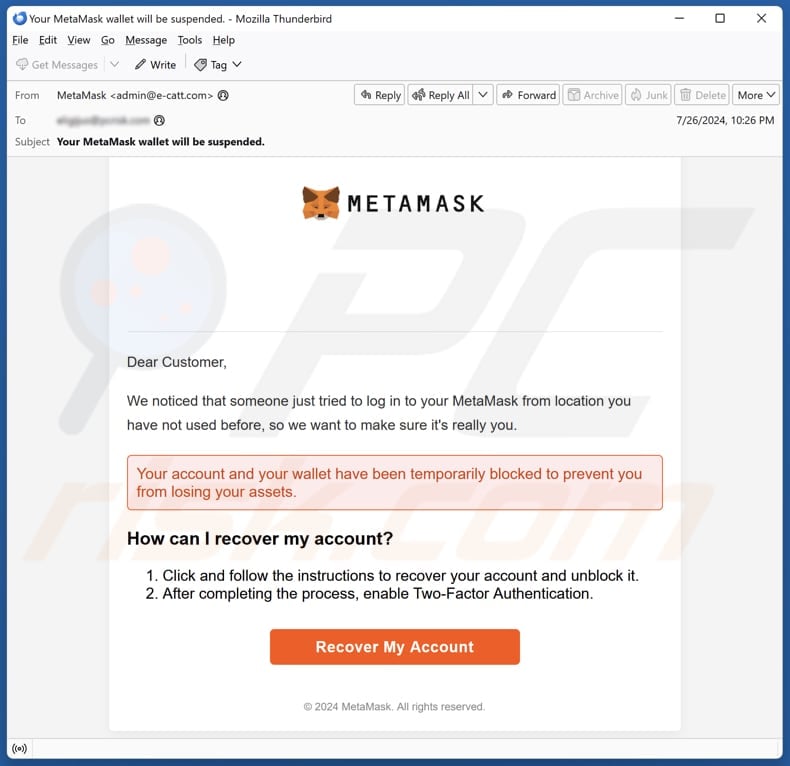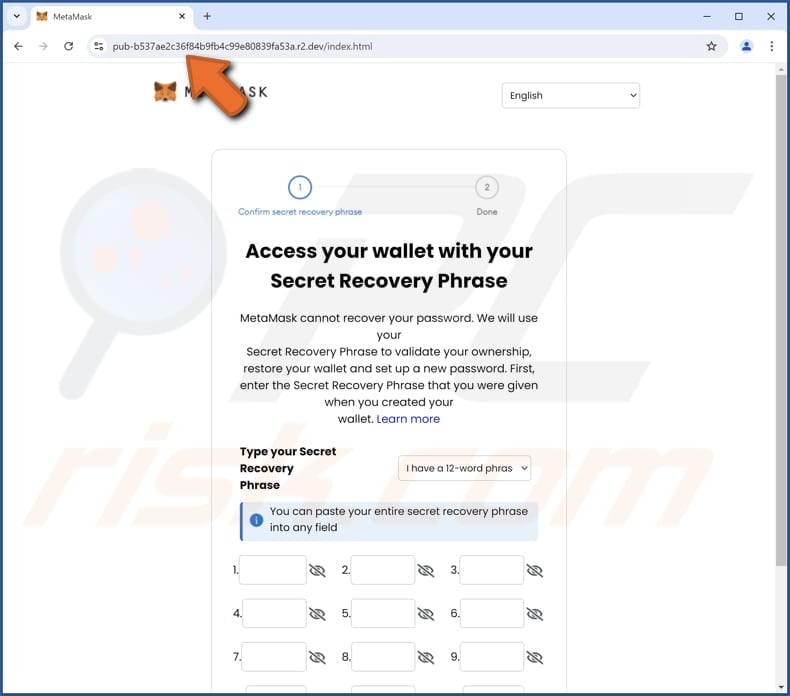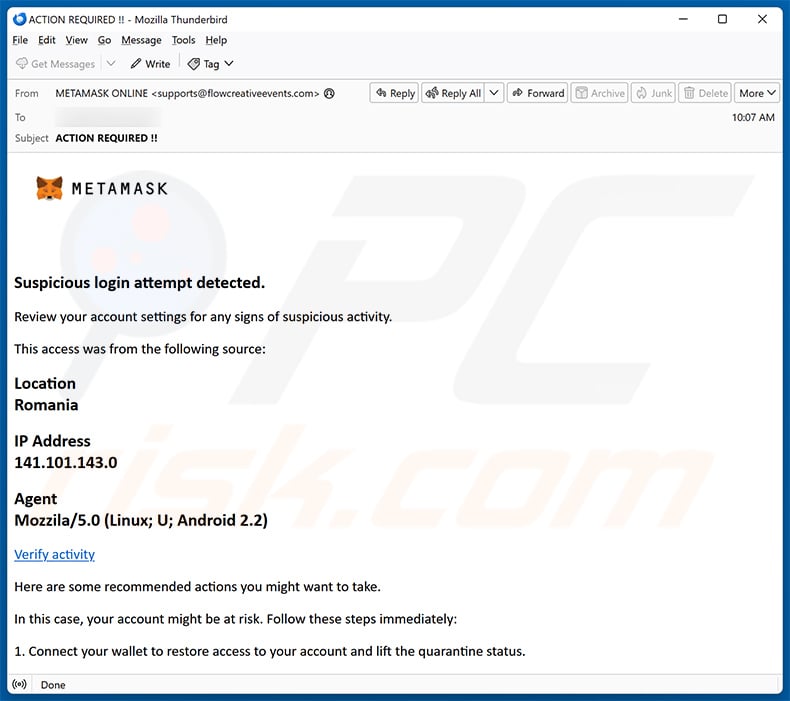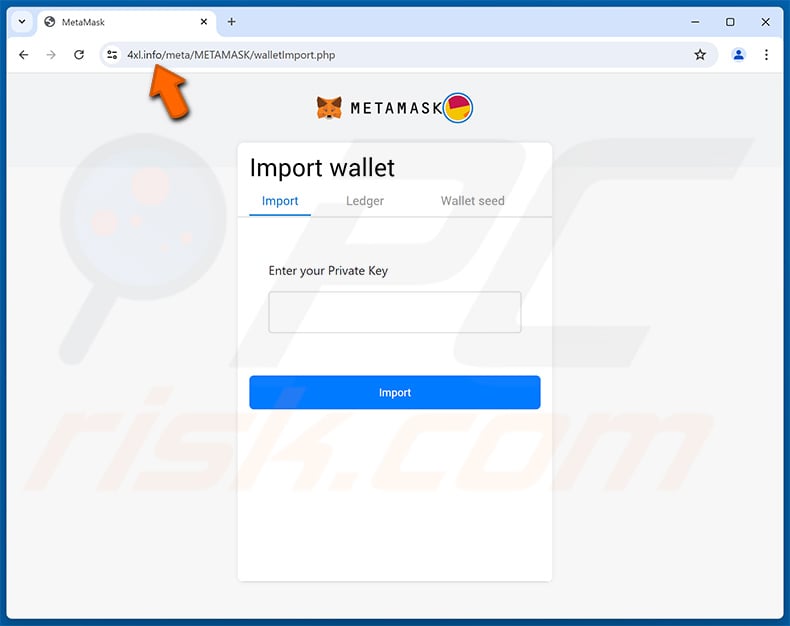How to identify scams like MetaMask Log-In Attempt email scam
Phishing/ScamAlso Known As: MetaMask Log-In Attempt phishing email
Get free scan and check if your device is infected.
Remove it nowTo use full-featured product, you have to purchase a license for Combo Cleaner. Seven days free trial available. Combo Cleaner is owned and operated by RCS LT, the parent company of PCRisk.com.
What is the "MetaMask Log-In Attempt" scam?
We have inspected this email and concluded that it is a phishing attempt masquerading as a notification regarding the suspension of the recipient's MetaMask wallet. This scam email is created by scammers with the intention of extracting personal information from recipients. Whoever receives this email should ignore it.

More about the "MetaMask Log-In Attempt" scam email
The phishing email claims to be from MetaMask and warns the recipient that their wallet will be suspended due to a login attempt from an unfamiliar location. It states that the account and wallet have been temporarily blocked to protect the user's assets. The email instructs the recipient to click a link to recover and unblock their account.
Additionally, the email urges the recipient to enable Two-Factor Authentication after completing the recovery process. The link in this email (the "Recover My Account" button) leads to a fake MetaMask website requesting users to restore their wallets by entering their secret recovery phrase.
Apparently, scammers aim to steal wallet recovery phrases from users. With this information, they might access cryptocurrency wallets and drain them (steal cryptocurrency holdings from victims). Thus, it is strongly recommended not to trust such emails (and websites included in them) to avoid monetary loss and other issues like identity theft.
It is important to note that MetaMask is a legitimate software cryptocurrency wallet developed by Consensys and it has nothing to do with this scam email.
| Name | MetaMask Log-In Attempt Email Scam |
| Threat Type | Phishing, Scam, Social Engineering, Fraud |
| Fake Claim | The recipients MetaMask account and wallet has been temporarily blocked |
| Disguise | Notification from MetaMask |
| Symptoms | Unauthorized online purchases, changed online account passwords, identity theft, illegal access of the computer. |
| Distribution methods | Deceptive emails, rogue online pop-up ads, search engine poisoning techniques, misspelled domains. |
| Damage | Loss of sensitive private information, monetary loss, identity theft. |
| Malware Removal (Windows) |
To eliminate possible malware infections, scan your computer with legitimate antivirus software. Our security researchers recommend using Combo Cleaner. Download Combo CleanerTo use full-featured product, you have to purchase a license for Combo Cleaner. 7 days free trial available. Combo Cleaner is owned and operated by RCS LT, the parent company of PCRisk.com. |
Similar scam emails in general
Phishing emails like the one described in our overview often mimic legitimate organizations, companies, or other entities and create a sense of urgency to deceive recipients. Recipients should be cautious and verify the authenticity of such emails before clicking on any links or providing personal information, as these emails aim to steal sensitive data. Moreover, cybercriminals can use fraudulent emails to distribute malware.
Some examples of similar scams are "Wells Fargo - Unusual Account Activity Email Scam", "Account Department Email Scam", and "Westside Auto Wholesale Email Scam".
How do spam campaigns infect computers?
Cybercriminals use email to spread malware by deceiving users into clicking on harmful links or opening infected attachments. These attachments can be executable files, MS Office documents, PDFs, compressed archives, JavaScript files, and other files. However, not all malicious files trigger infections right away upon being opened.
For example, malicious executable files can infect computers immediately after being run, whereas MS Office documents require users to enable macro commands to inject malware. Links in emails from cybercriminals can lead users to websites that trick them into downloading malware. These sites may also be designed to start downloading malware automatically (without user interaction).
How to avoid installation of malware?
Always use official web pages (or app stores) for software and file downloads. Avoid using third-party downloaders, P2P networks, torrent sites (and other dubious pages), and similar sources. Do not trust pop-ups, ads, warnings, etc., on questionable sites, and avoid opening links or files in unexpected emails from unknown addresses.
Furthermore, use a reputable security tool and scan your computer for threats regularly. Keep all software and the operating system up to date. If you have already opened malicious attachments, we recommend running a scan with Combo Cleaner Antivirus for Windows to automatically eliminate infiltrated malware.
Text presented in the "MetaMask Log-In Attempt" email letter:
Subject: Your MetaMask wallet will be suspended.
Dear Customer,
We noticed that someone just tried to log in to your MetaMask from location you have not used before, so we want to make sure it's really you.
Your account and your wallet have been temporarily blocked to prevent you from losing your assets.
How can I recover my account?Click and follow the instructions to recover your account and unblock it.
After completing the process, enable Two-Factor Authentication.Recover My Account
2024 MetaMask. All rights reserved.
Screenshot of the fake MetaMask website used in this scam:

Another example of MetaMask login attempt-themed spam email promoting a phishing site:

Text presented within:
Subject: ACTION REQUIRED !!
METAMASK
Suspicious login attempt detected.
Review your account settings for any signs of suspicious activity.
This access was from the following source:
Location
RomaniaIP Address
141.101.143.0Agent
Mozzila/5.0 (Linux; U; Android 2.2)Verify activity
Here are some recommended actions you might want to take.
In this case, your account might be at risk. Follow these steps immediately:
1. Connect your wallet to restore access to your account and lift the quarantine status.
Screenshot of the promoted phishing site:

Instant automatic malware removal:
Manual threat removal might be a lengthy and complicated process that requires advanced IT skills. Combo Cleaner is a professional automatic malware removal tool that is recommended to get rid of malware. Download it by clicking the button below:
DOWNLOAD Combo CleanerBy downloading any software listed on this website you agree to our Privacy Policy and Terms of Use. To use full-featured product, you have to purchase a license for Combo Cleaner. 7 days free trial available. Combo Cleaner is owned and operated by RCS LT, the parent company of PCRisk.com.
Quick menu:
- What is MetaMask Log-In Attempt phishing email?
- Types of malicious emails.
- How to spot a malicious email?
- What to do if you fell for an email scam?
Types of malicious emails:
![]() Phishing Emails
Phishing Emails
Most commonly, cybercriminals use deceptive emails to trick Internet users into giving away their sensitive private information, for example, login information for various online services, email accounts, or online banking information.
Such attacks are called phishing. In a phishing attack, cybercriminals usually send an email message with some popular service logo (for example, Microsoft, DHL, Amazon, Netflix), create urgency (wrong shipping address, expired password, etc.), and place a link which they hope their potential victims will click on.
After clicking the link presented in such email message, victims are redirected to a fake website that looks identical or extremely similar to the original one. Victims are then asked to enter their password, credit card details, or some other information that gets stolen by cybercriminals.
![]() Emails with Malicious Attachments
Emails with Malicious Attachments
Another popular attack vector is email spam with malicious attachments that infect users' computers with malware. Malicious attachments usually carry trojans that are capable of stealing passwords, banking information, and other sensitive information.
In such attacks, cybercriminals' main goal is to trick their potential victims into opening an infected email attachment. To achieve this goal, email messages usually talk about recently received invoices, faxes, or voice messages.
If a potential victim falls for the lure and opens the attachment, their computers get infected, and cybercriminals can collect a lot of sensitive information.
While it's a more complicated method to steal personal information (spam filters and antivirus programs usually detect such attempts), if successful, cybercriminals can get a much wider array of data and can collect information for a long period of time.
![]() Sextortion Emails
Sextortion Emails
This is a type of phishing. In this case, users receive an email claiming that a cybercriminal could access the webcam of the potential victim and has a video recording of one's masturbation.
To get rid of the video, victims are asked to pay a ransom (usually using Bitcoin or another cryptocurrency). Nevertheless, all of these claims are false - users who receive such emails should ignore and delete them.
How to spot a malicious email?
While cyber criminals try to make their lure emails look trustworthy, here are some things that you should look for when trying to spot a phishing email:
- Check the sender's ("from") email address: Hover your mouse over the "from" address and check if it's legitimate. For example, if you received an email from Microsoft, be sure to check if the email address is @microsoft.com and not something suspicious like @m1crosoft.com, @microsfot.com, @account-security-noreply.com, etc.
- Check for generic greetings: If the greeting in the email is "Dear user", "Dear @youremail.com", "Dear valued customer", this should raise suspiciousness. Most commonly, companies call you by your name. Lack of this information could signal a phishing attempt.
- Check the links in the email: Hover your mouse over the link presented in the email, if the link that appears seems suspicious, don't click it. For example, if you received an email from Microsoft and the link in the email shows that it will go to firebasestorage.googleapis.com/v0... you shouldn't trust it. It's best not to click any links in the emails but to visit the company website that sent you the email in the first place.
- Don't blindly trust email attachments: Most commonly, legitimate companies will ask you to log in to their website and to view any documents there; if you received an email with an attachment, it's a good idea to scan it with an antivirus application. Infected email attachments are a common attack vector used by cybercriminals.
To minimise the risk of opening phishing and malicious emails we recommend using Combo Cleaner Antivirus for Windows.
Example of a spam email:

What to do if you fell for an email scam?
- If you clicked on a link in a phishing email and entered your password - be sure to change your password as soon as possible. Usually, cybercriminals collect stolen credentials and then sell them to other groups that use them for malicious purposes. If you change your password in a timely manner, there's a chance that criminals won't have enough time to do any damage.
- If you entered your credit card information - contact your bank as soon as possible and explain the situation. There's a good chance that you will need to cancel your compromised credit card and get a new one.
- If you see any signs of identity theft - you should immediately contact the Federal Trade Commission. This institution will collect information about your situation and create a personal recovery plan.
- If you opened a malicious attachment - your computer is probably infected, you should scan it with a reputable antivirus application. For this purpose, we recommend using Combo Cleaner Antivirus for Windows.
- Help other Internet users - report phishing emails to Anti-Phishing Working Group, FBI’s Internet Crime Complaint Center, National Fraud Information Center and U.S. Department of Justice.
Frequently Asked Questions (FAQ)
Why did I receive this email?
Scammers send identical emails to thousands of people, hoping that some will be tricked. As a rule, these emails are generic and do not contain personal details such as names or other identifiable information.
I have provided my personal information when tricked by this email, what should I do?
If you have provided your recovery phrase, change it as soon as possible. If you cannot access your cryptocurrency wallet, contact the service provider and inform them about the situation.
I have downloaded and opened a malicious file attached to an email, is my computer infected?
If you run an executable file, your system is probably infected. On the other hand, if the file was a document (such as a .pdf or .doc), your computer might be safe since opening these documents does not always result in malware activation.
I have read the email but did not open the attachment, is my computer infected?
Simply opening an email is generally safe and does not pose a threat to your system. However, malware can infect your system when you click links or open attachments in fraudulent emails.
Will Combo Cleaner remove malware infections that were present in email attachment?
Yes, Combo Cleaner can detect and remove nearly all known malware infections. However, advanced malware often hides deeply within the system, so a full system scan is required to ensure complete removal.
Share:

Tomas Meskauskas
Expert security researcher, professional malware analyst
I am passionate about computer security and technology. I have an experience of over 10 years working in various companies related to computer technical issue solving and Internet security. I have been working as an author and editor for pcrisk.com since 2010. Follow me on Twitter and LinkedIn to stay informed about the latest online security threats.
PCrisk security portal is brought by a company RCS LT.
Joined forces of security researchers help educate computer users about the latest online security threats. More information about the company RCS LT.
Our malware removal guides are free. However, if you want to support us you can send us a donation.
DonatePCrisk security portal is brought by a company RCS LT.
Joined forces of security researchers help educate computer users about the latest online security threats. More information about the company RCS LT.
Our malware removal guides are free. However, if you want to support us you can send us a donation.
Donate
▼ Show Discussion